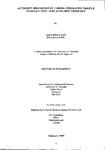ANTIMONY SPECIATION BY CHROMATOGRAPHIC SAMPLE INTRODUCTION TO PLASMA SPECTROSCOPY
| dc.contributor.author | GUY, ALEN BRUCE | |
| dc.contributor.other | School of Geography, Earth and Environmental Sciences | en_US |
| dc.date.accessioned | 2013-09-13T08:56:35Z | |
| dc.date.available | 2013-09-13T08:56:35Z | |
| dc.date.issued | 1999 | |
| dc.identifier | NOT AVAILABLE | en_US |
| dc.identifier.uri | http://hdl.handle.net/10026.1/1675 | |
| dc.description.abstract |
Antimony (Sb), an element in Group V of the Periodic Table, has an ancient and varied chemistry with many applications in industry and medicine. However, although sensitive analytical methods exist for the determination of Sb very tittle is known about the speciation of the element. It is widely known that the toxicity of Sb is not only dependent upon its oxidation state but also its molecular form. Thus this study has utilised chromatographic sample introduction directly coupled to plasma spectroscopic instruments to facilitate separations of Sb based upon molecular form coupled with sensitive detection methods. Fundamental studies, using NMR to investigate physical changes in ligands and ESI-MS to investigate molecular ions, have shown that complexes of Sb(V) can form with compounds that might exist in biological/environmental systems, such as a-hydroxyacids. These complexes have been separated using ion-exchange and reversed-phase chromatography for the first time. A fundamental investigation of the nebuliser/spray chamber assembly was carried out in terms of the effect on the quality of the chromatographic separations. It was found that the resolution was strongly dependent upon choice of nebuliser and spraychamber. Five nebulisers and two spray-chambers were studied with the Burgener nebuliser/cyclonic spray-chamber pairing being the most useful analytically. The methods developed from these fundamental studies were applied to environmental water, plant and sediment sample extracts as well as industrial polymer leachates. These studies have shown that Sb(V) was the favoured form in terrestrial water samples, agreeing with thermodynamic assumptions. However, more unidentified Sb species were detected in sediment and plant (liverwort, moss) extracts. Hydride generation (HG) apparatus placed in-line between the HPLC and the plasma instrument facilitated analysis of reducible species and it was found that for many samples not all the Sb was in a reducible form. This was confirmed by comparison with chromatograms for analysis without HG. Sample spiking experiments showed that dissolved complexing agents from the samples would produce striking differences in chromatograms, i.e. in one case all peaks would respond to the spike whereas in another sample only one peak would respond. This was a novel discovery in this field of speciation and has highlighted possible new chemistries for trace levels of environmental Sb. This indicated the need for further studies of the complex nature of Sb in trace and ultra-trace levels in the environment leading to the production of specific reference materials. Investigation of industrial samples showed that significant work is still required especially in the area of the chromatographic elution of Sb(IlI) species from columns packed with a high percentage of aromatic organic material. | en_US |
| dc.description.sponsorship | Engineering & Physical Sciences Research Council; and ICI Technology Wilton Middlesborough Teesside | en_US |
| dc.language.iso | en | en_US |
| dc.publisher | University of Plymouth | en_US |
| dc.title | ANTIMONY SPECIATION BY CHROMATOGRAPHIC SAMPLE INTRODUCTION TO PLASMA SPECTROSCOPY | en_US |
| dc.type | Thesis | |
| plymouth.version | Full version | en_US |
| dc.identifier.doi | http://dx.doi.org/10.24382/3456 | |
| dc.identifier.doi | http://dx.doi.org/10.24382/3456 |
Files in this item
This item appears in the following Collection(s)
-
01 Research Theses Main Collection
Research Theses Main


